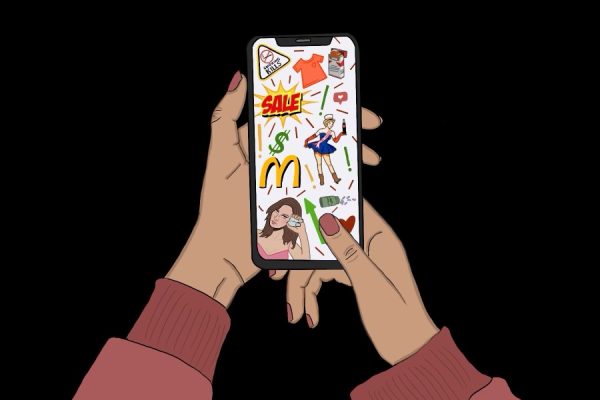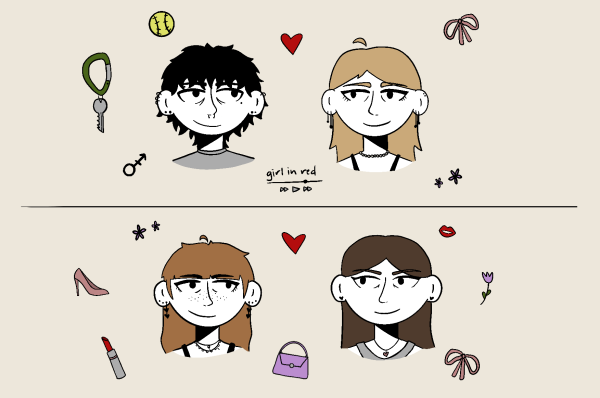Finding the gray area around pink and blue
What is segregated by pink verses blue, dolls versus trucks, and home life versus adventures? Hint its not a toy catalogue from the 1950s.
Its the toy section of Wal-Mart in 2013.
The backstory: over winter break, I found myself wandering the aisles of Wal-Mart in search of a toy for a 7 year-old girl. She is not into pink or sparkly things, so I went in to find a toy that was nothing like a Barbie princess.
Upon finding the toy section, I was taken aback by the extreme division between toys for girls and toys for boys.
The girls aisle was overflowing with dolls, pink kitchen supplies, bedazzled makeup kits, and princess-themed art supplies.
In contrast, the boy section featured Nerf guns, super hero athletic gear, and Lego sets.
As adults, it is accepted that not all women are obsessed with pink, and not all men are sports fanatics. We are given the freedom to choose clothes, accessories, gadgets, and other items with more nuances that are less gender-specific.
So why are children encouraged to fall into the archaic stereotypes of masculine or feminine? Its the twenty-first century for crying out loud.
Traditional gender roles are finally breaking down, and it is time that the toy industry reflects that.
I am not alone in my quest for more gender-neutral toys. McKenna Pope, a 13 year-old from New Jersey, received nation-wide attention for a petition she to wrote on Change.org challenging sexism in the toy industry.
In an interview with CNN, she explained that her 4 year-old brother, who aspires to be a chef, wanted an Easy-Bake oven for Christmas.
The only ovens she could find in stores were pink or purple, and had pictures of girls playing with them on the box.
McKennas petition, which has received over 45,000 signatures on Change.org, wrote, I feel that this sends a clear message: women cook, men work. The Huffington post says Hasbro, the manufacturer of Easy-Bake ovens, responded to her petition by agreeing to market ovens to boys and girls, and to introduce a new range of colors including silver and black.
This is the kind of success story we need to see in order to change the sexist nature of the toy industry. If a boy wants to learn how to sew, why should all the sewing kits show girls on the front of the box?
And if a girl wants to play with Nerf guns, why should they solely be marketed to boys?
Some argue that boys will always prefer trucks to dolls, and girls will always favor pink over blue. We have not given kids a chance to make these decisions in a way that is independent of consumer targeting and cultural gender messages.
Instead of having boy and girl aisles, Wal-Mart and other retailers should have toy sections based on themes. Harrods, a British store, adopted this department organization this year.
With more liberty to choose, I suspect that children and parents will be attracted to a new generation of toys.
The stereotypes of masculine and feminine are becoming less extreme, and it is high time that the toy industry progressed from their outdated mentality.
Since the development of so-called beauty enhancing products in Ancient Egypt, human kind has had the ability to change peoples faces. Standards of beauty exist in some form everywhere and are important to many people.
There comes a point, however, when society has to set limits for these ideals and think rationally about their consequences.
An art form that has its origin in bees wax and castor oil is now a multi-billion dollar industry ranging from hair and makeup, to fashion and weight loss programs.
This monopolized conception of beauty comes with a slew of social pressures that dictate status, success, capability and desirability over American women.
A typical critique of the beauty industry is that men control it. Whether or not this is true does not matter.
A website, titled The Anti-Feminist, posted an account of a Pick Up Artists travels to England. It discussed how the women there were not appealing to him due to their haggard faces, saying, you know theyre not that old, but they just look old, like theyve been working in a factory or coal mine their entire lives. He then urged other artists not to waste their time in England, for there were far more satisfying women in other parts of Europe.
These kinds of messages suggest that regardless of whether an aspect of beauty is praised or jeered, the physical attributes of women in the media are far more important than their actual capabilities.
With so many divergent opinions on what beauty is, what point is there in aspiring to any standard other than the naturalness of the individual?
This seems like such an overly simplified point. Yet it affects both men and women. An industry that heavily controls the images of women also makes the assumption that all men are attracted to one, unattainable image of bodily perfection. Its a lose-lose situation.
This falsified image of a ready and fertile woman assuming reproductive capability is still a driving force in beauty is detrimental to the female population. It is degrading to their intellectual, physical, and emotional existence.
The only viable response to such an overbearing force of control in our society is to use consumer power to determine what products are produced and sold and at what quantity.
Stacy Malkan says, Women absolutely have the power to control the nature of every consumer product on the market. This is achieved simply through choosing what to buy, if anything, and from where. These simple decisions can make an astronomical impact, save money, and have a positive influence on generations to come.



![Can’t buy me [self] love](https://vtcynic.com/wp-content/uploads/2024/04/self-care-FINAL-600x398.jpg)







